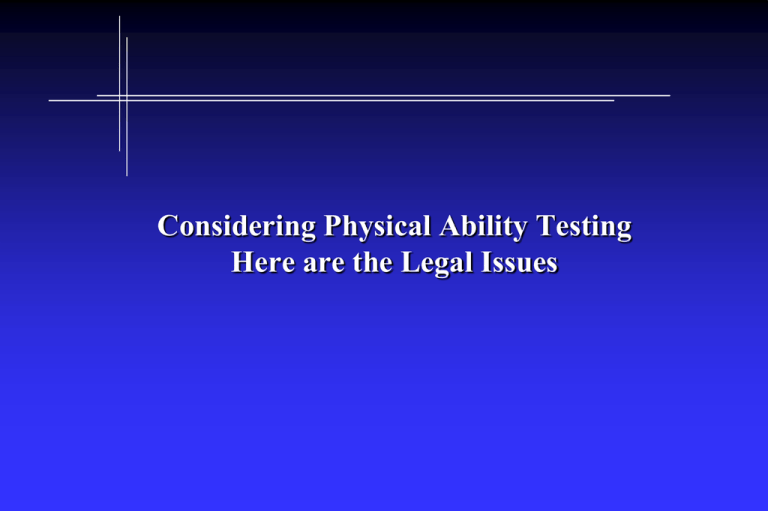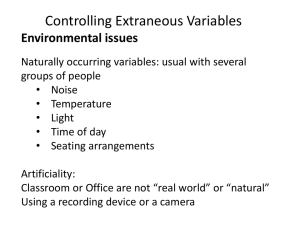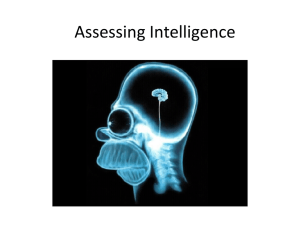
Considering Physical Ability Testing
Here are the Legal Issues
EMPLOYMENT LAWS
Title VII of the Civil Rights Act of 1964
Age Discrimination Act of 1967
Uniform Guidelines on Employee Selection
Procedures – 1978
Americans With Disabilities Act - 1992
Uniform Guidelines on Employee Selection Procedures
CFR-20 Chapter 60-3
US Department of Labor
Established in 1978.
Designed to comply with Federal law prohibiting
employment practices which discriminate on the
grounds of race, color, religion, sex, and national
origin. 60-3.1 (B)
Apply to tests and other selection procedures which
are used as a basis for any employment decision.
60-3.2 (B)
Uniform Guidelines (cont.)
Employment decisions include but are not limited to
hiring, promotion, demotion, membership, referral,
retention, licensing, certification (does not apply to
recruitment). 60-3.2 (B)
The use of any selection procedure that has an adverse
impact on the hiring, promotion, or other employment
opportunities of members of any sex, age, or ethnic
group will be considered to be discriminatory unless it
has been validated or the provisions of section 6 of this
part are satisfied. 60-3.3 (A)
60-3.6 The use of Selection Procedures which have not
been validated
Use of Alternative selection procedures to eliminate
adverse impact. Alternative procedures should eliminate
the adverse impact in the total process.
When validity Studies cannot/need not be performed
Use selection procedures which are as job related as
possible and which minimize or eliminate adverse
impact.
60-3.6 The use of Selection Procedures which have not
been validated (Continued)
Where informal or un-scored procedures are used;
Which has an adverse impact, modify the procedure to a
formal, scored or quantified measure or combination of
both, then validate.
Where formal and scored procedures are used; When a
user cannot or need not validate the test, the user should
modify the procedure to eliminate the adverse impact or
justify continued use of the test in accord with Federal
Law
LEGAL REQUIREMENTS
Job
Relatedness
Essential Job Functions
Reasonable Accommodation
Objective Testing
Predictive of Job Performance
“VALIDATION”
60-3.9 (A) Unacceptable Substitutes for
Evidence of Validity
Marketing material
A letter from an Attorney stating validity
Validity documents for other jobs or employers
Job task analysis
Anything other than a proper Validation
document
VALIDATION DOCUMENTATION
60-3.15
How the job’s physical demands were analyzed
A detailed description of the test battery
How the tests measure the physical abilities of
an individual
A review of alternative tests that might reduce
“Adverse Impact” 60-3.3 B
How the pass/fail criteria relate to job requirements
How the test battery is intended to be used
Steps taken to assure accuracy and completeness
Validation Studies (Three Types)
60-3.5 General Standards for Validity Studies
Criterion-related Validity
Content Validity
Construct Validity
Case Studies
EEOC v Dial Corporation
Why was the test not validated
Indergard v Georgia-Pacific Corp
What makes a test a medical exam
Job Analysis and Test Design
Perform Detailed Onsite Analysis
Determine Strength, Endurance,
Postural/Agility Demands
Recommend Worksite Redesign
Define Essential Functions
Develop Job-Specific Test Battery
with Essential Pass/Fail Criteria
Have you seen this guy?
Strength Tests
Dynamic Lifts
Static Lifts
Energy Expenditure
Determination
IMPLEMENTATION PROCESS
Detailed Job analysis
Worker survey to confirm essential functions
Test battery and pass/fail criteria proposed
Test battery reviewed and approved by employer
Testing initiated
EEOC documentation completed
Evaluation of program effectiveness at one year
RETURN ON INVESTMENT
Example Calculation
$550,000/100 =
100 x 30% injury reduction =
30 x $5500 =
1000 x 30% turnover =
360 x $100 =
$165,000 - $36,000 =
$165,000/$36,000 =
$5500 average cost/injury
30 injuries saved
$165,000 cost savings
300 annual hires + (20% fail)
$36,000 testing costs
$129,000 net cost savings
4.5 to 1 ROI
Appropriate Industry Types
Distribution – Retail Merchandise, Grocery,
Beverage, Furniture, etc.
Transportation – Trucking, Airlines, etc.
Manufacturing – Steel, Large parts or components
Other Industry Possibilities
Hospitals – Patient lifting
Nursing Homes – Patient lifting
Ambulance/EMT – Patient lifting
Fire Departments/Training Academy – Lifting
and Cardiovascular demands
Utility/Public Works – Lifting and Cardiovascular
demands
Others – Is lifting > 35lbs? Do workers fatigue?
Appropriate Types of Jobs
Significant strength demands – i.e. lifting > 35lbs.
Frequent whole body movements = endurance demand
Essential specific posture/agility demands – climbing,
confined space, CPR
15 or more employees in job title
Job Analysis and Test Design
Detailed analysis – weigh, measure, observe, define
essential physical demands
Heart rate monitors used for endurance demand – 15
workers per job title
Average 1 to 2 days onsite – may need to return for more
heart rate data
Design job-specific test and proposed pass/fail criteria
Summary
You Should Now Know At Least
The Following Things About
Physical Abilities Testing
Uniform Guidelines on Employee Selection Procedures
CFR-20 Chapter 60-3
US Department of Labor
The use of any selection procedure that has an adverse impact
on the hiring, promotion, or other employment
opportunities of members of any sex, age, or ethnic group
will be considered to be discriminatory unless it has been
validated.
Steps 1-2-3
#1 Ask the person who developed or will develop
the test, “If the test is validated according to the
Uniform Guidelines?”
#2 Ask them to furnish the validation document
#3 Ask for adverse impact documentation
60-3.9 (A) Unacceptable Substitutes for
Evidence of Validity
Marketing material
A letter from an Attorney stating validity
Validity documents for other jobs or employers
Job task analysis
Anything other than a proper Validation
document
In Closing
The face of the American workforce has changed over the last 20
years. You may be hiring your next injury.
To protect your company, you can test applicants for physically
demanding jobs such as materials handling, etc.
Employers can test New Hire applicants and refuse to hire those who
fail a physical ability test that is based on the job. Testing can
also be done for Return to Work, Transfers and Annual Fitness
Reviews.
AEI Contact Information
Jim Briggs, OTR/L
Vice President of Business Development
jim.briggs@advancedergonomics.com
1-800-682-0169 Ext 445
615-594-4070 Cell







